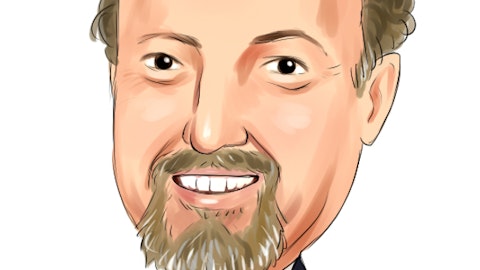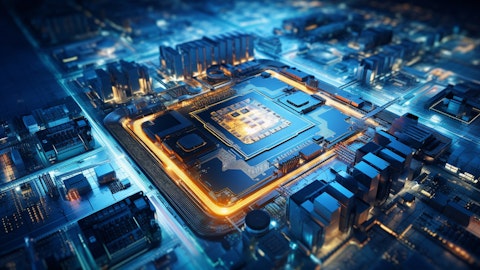Timothy Archer: Well, I would say, the only thing I would say is because there’s been lots of questions about whether Lam’s market share in defense and others, we’re not quite indifferent because the power of the installed base is that, again, when the customer’s preferred path is to upgrade what they already have, it means that the positions don’t change. And so Lam’s very strong position carries forward in that case. So agnostic from a financial perspective, but obviously our position in the industry continues to strengthen through each of those great cycles.
Stacy Rasgon: Got it. That’s helpful. For my follow-up again, I wanted to go back to the segment expectations in China. So I know this I think was Doug said you didn’t have anything to tell us on segments. But if I look at your slide deck on slide 5, if I’m reading unless I’m reading it wrong it does seem to suggest that you see, it says sustained investment in domestic China for DRAM in calendar ‘24 and weakness in foundry logic, so is that actually what you’re expecting? The China degradation through the year in foundry logic and DRAM sustaining or is this slide, am I just reading the slide wrong?
Doug Bettinger : Yes, no. Spacey you kind of have one customer in China DRAM. So I got to be careful talking about that. China is going to modulate through the year, all right, it’s not going to stay at 42% is the statement that I made and it’s going to modulate in every segment I believe in the China region.
Stacy Rasgon: Okay, I mean the slide says just to expect us led by a HAM sustained investment in domestic China under DRAM. So that’s not what’s going to happen?
Doug Bettinger : Unfortunately, I know the slides in primary right now states you were having some technical challenges. It’s all going to modulate.
Timothy Archer: Slide 5 when you pull it up.
Operator: Our next question comes from Vivek Arya from Bank of America Securities.
Vivek Arya: Thanks for taking my question, I wanted to revisit your comment about spares doubling. How important is that data point like what were you expecting instead of versus the actual result? And how much does it increase your confidence about NAND recovery because you’re not really increasing the WFE expectations for this year, right? So on surface this comment about spares doubling sounds, like a very important data point. But I’m not sure how to quite put that in context of what it means for Lam this year.
Doug Bettinger : Okay, well, Vivek, we didn’t say spares would double. We said that it was a double-digit percent growth quarter-on-quarter in our spares revenue, so not doubling. But I think that in general, I mean, the way we look at that and why we made that comment, obviously it’s positive for us to see spares move up. If you think, go back to our commentary previously about CSPG over the last few years. We’ve said spares revenue will grow year-on-year because the installed base itself grows. However, through this downturn, the cuts in fabulization were so severe that we actually saw spares revenue come down, which surprised us a bit. So maybe to your point of expectations, we knew that as soon as customers started to utilize the fabs and bring some of the tools back online, we would see spares increase.
We said that would be the first sign that the end market was really starting to improve. And so the reason we called it out was that obviously it further confirms, I think, what you’re hearing from our customers, which is that utilization is starting to improve. It doesn’t tie to WFE because utilization, what you have, is one issue. When you choose to spend more to either upgrade technology or add capacity is a second decision. We said that is likely still more of a 2025 event on the equipment spend side. But you have to get the first indication, which is utilization improvement, spares improving, and then the rest will come.
Vivek Arya: And then the other thing on the call, I believe that you mentioned CSPG will be flat year or did I not hear that properly or did you mean it sequentially or did you mean it for this calendar year? Because if it is for the calendar year, that implies pretty strong kind of mid-teens growth in the second half. So if you could clarify what you said about CSPG growth and whatever timeframe you were referring to.
Doug Bettinger : Yes, I said flattish, Vivek, plus or minus flat, and by the way, that’s not a new disclosure. We said that last quarter as well.
Vivek Arya: For this calendar year or for –
Doug Bettinger : Correct, for this calendar year, yes. ‘24 over ‘23.
Operator: Our next question comes from Chris Caso from Wolfe Research.
Christopher Caso: Yes, thank you. I guess the first question is on DRAM, and could you perhaps talk about some of the moving parts that are going on with that right now? And I think a previous question you talked about, the China part of DRAM expecting that to moderate through the year. Obviously, the direct revenue from HBM sounds good, but there’s a broader capacity question going on in DRAM that’s fungible with HBM. Could you talk about, what your expectations are for that as the year progresses?
Timothy Archer: Yes. Let me start. I think just to address this one point about the fungibility of capacity, you’re correct. Obviously, if you’re looking at DDR5, I think we’ve made a couple of comments in the past, though. One, we’re talking specifically about the additional tools that are needed to enable HBM. So that’s why we talk about our electroplating and our Indian silicon etch tools, because those are added to whatever capacity you might have for DRAM. You need to add those tools to make HBM possible. And so that’s what we’re seeing rise by 3X this year. On the second side, when you go from conventional DRAM to HBM, our customers have talked about and the industry has talked about the much larger die size because you’ve had to create the real estate that’s needed to add the TSVs. And so, while you may be able to translate some of the same DRAM equipment over to produce the same number of bits, you’ll need more of that equipment as well.
So, those are the key drivers as you’re moving for additional spending growth as you move into HBM, DRAM.
Christopher Caso: Got it. As a follow-up, you made in your prepared remarks a comment talking about a billion dollars in revenue from gate-all-around this year. Could you talk about that in context of, where the overall opportunity is for gate-all-around? Is this — is that billion represent, what you would consider to be gate-all-around capacity? Is that just getting the processes started, kind of where are we with that gate-all-around ramp?
Timothy Archer: Yes, I mean, I think it’s, we’re really just starting at gate-all-around. Our comment was a billion dollars of shipments into the gate-all-around nodes this year. And it’s across all of our types of products that help enable gate-all-around smaller technology nodes. And so what we’ve said is that every technology node, etch in-depth intensity grows, and our SAM opportunity expands. So gate-all-around being an important node where there’s need for new tools from Lam, like in our selective etch product portfolio or in our ALB product portfolio, that might not have existed to the same degree in prior nodes. And so those are the areas where we’re seeing growth, as well as just growth in the rest of our advanced technology products in etch in-depth.
Ram Ganesh: Thank you, Chris. Operator, we’ll take one more question.
Operator: Our next and final question comes from Brian Chin from Stifel.
Brian Chin: Hi, there. Thanks for sneaking me in. The companies previously discussed an incremental $1 billion to $1.5 billion increase in WFE for every 1% AI server penetration. Last year, given the under-utilization of capacity and the focus on conversion activity, maybe the math was lower last year. But now that utilization rates for advanced foundry and DRAM nodes have recovered, do you see AI growth, I guess, driving spending levels more consistent with that $1 billion to $1.5 billion? And do you already see that maybe playing out to some degree in your order backlog?
Doug Bettinger : Yes, Brian, we’re not going to talk about order backlog. But the statements we made, and you’ve got it right, which was for every percent that it’s an AI server versus an enterprise-class server because of the eight times DRAM, much bigger logic die, the GPUs, and the 3x NAND, it’s a $1 billion to $1.5 billion amount of WFE. And that’s absolutely still how we see it. And but you’re right, if things are underutilized, you don’t need to spend nearly as much. But that’s a temporary situation. Eventually, things get back to being utilized.
Brian Chin: Okay. Yes, that’s helpful, and then maybe just kind of follow-up on the last follow-up but again of that $1 billion kind of shipment for gate-all-around in 2024 calendar year, how much of that is second half weighted? Is it more kind of pilot production or how much is it pilot versus high volume?
Timothy Archer: Yes, we’re not going to give color on exactly when we’re shipping just because we think that’s more for our customers to talk about in terms of their expansion on those notes.
Brian Chin: Okay, fair enough. I think it is more second half bias. Thanks.
Ram Ganesh: Thanks operator.
Timothy Archer: That concludes our remarks guys. Thanks for joining the call.
Operator: Ladies and gentlemen with that, we’ll conclude today’s conference call and presentation. We thank you for joining. You may now disconnect your lines.
Follow Lam Research Corp (NASDAQ:LRCX)
Follow Lam Research Corp (NASDAQ:LRCX)
Receive real-time insider trading and news alerts





